
From
George W. Bush's speech, March 20, in Cleveland:
They built an eight-foot high, 12-mile long dirt wall that ringed the city. This wall was designed to cut off any escape for terrorists trying to evade security checkpoints.
* * *
The example of Tal Afar gives me confidence in our strategy because in this city we see the outlines of the Iraq that we and the Iraqi people have been fighting for.
From Peter Baker,
Washington Post, March 21:
Reports from the streets of Tall Afar, half a world away, offer a more complex story. U.S. forces last fall did drive out radicals who had brutalized the mid-size city near the Syrian border. But lately, residents say, the city has taken another dark turn. "The armed men are fewer," Nassir Sebti, 42, an air-conditioning mechanic, told a Washington Post interviewer Monday, "but the assassinations between Sunni and Shiites have increased."
* * *
Hashim said he has also seen indications lately that the insurgents have begun "seeping back in" to Tall Afar now that the 3rd Armored Cavalry Regiment has rotated home and been replaced by another Army unit. And given the deep ethnic and sectarian divides in Tall Afar, he said, it is quite possible that the city could succumb to civil war, along with the rest of the country.
A Washington Post employee interviewing residents of Tall Afar found continuing anxiety in the streets. "Al-Qaeda has started to come back again," said Jaafar al-Khawat, 33, a tailor. "They have started to kill Shiites and Sunnis who cooperate with the Americans. Last Wednesday, they killed a truck driver because he worked with the Americans."
Yasir al-Efri, 23, a law student at Mosul University, said al-Qaeda pamphlets began appearing on the biggest mosque in Tall Afar in the past two months claiming credit for attacks. "The Tall Afar mission failed," he said. "The city will turn back to how it was before the battle within two months. The Americans are busy putting cement barriers and barbed wire around their bases and no one is taking care of the infrastructure."
From
Wikipedia:
[M]ilitary historians are generally dismissive of the net value of this great wall. It was astonishingly expensive to build, maintain and garrison. The money the Ming spent on the wall could have been spent on other military capabilities such as European style artillery or muskets. The fact remains that the great wall was of no help at all in the Ming dynasty's fall.
 From George W. Bush's speech, March 20, in Cleveland:
From George W. Bush's speech, March 20, in Cleveland: 






1 comment:
This was an excellent post and I featured it today on my blog. I've also added you to my blogroll. Nice job.
Post a Comment